|
Displaying items by tag: shelburne museum
Connoisseurs of Vermont antiques have long sought to dispel notions that the furniture is rustic, and that the makers were eccentrics living on the edges of the wilderness. In the last few decades, historians and collectors have unearthed evidence that the state’s early woodworkers, even those farming in remote spots, kept up with trends in design, materials and tools. An exhibition surveying these sophisticated pieces, “Rich and Tasty: Vermont Furniture to 1850,” opens on July 25 at the Shelburne Museum in Vermont.
The Shelburne Museum is expecting a lot of visitors for its new exhibition that features some of the most famous paintings in the world. It's a very rare chance for people to see the paintings from French masters.
Museum staff was putting the finishing touches on a new exhibition that opens to the public Saturday. It is called "In a New Light; French impressionism arrives in America." The centerpiece is Monet's "Le Pont, Amsterdam." It is the very first painting by Monet to become part of an American collection. It was bought from the artist in Paris by Louisine Havemeyer, mother of Shelburne Museum found Electra Havemeyer Webb.
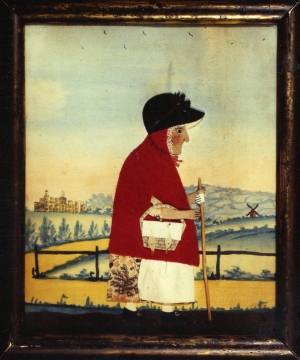
In this country, we don’t really go in for folk art – or at least, not in the way America does. Yes, there’s a collection of folk art on display at Compton Verney and another at the American Museum in Bath, but mostly it’s shown in local and regional museums. There’s nothing here on the scale or importance of the 150,000 works of art in the Shelburne Museum in Vermont or the American Folk Art Museum in New York City.
British condescension towards the whole subject was encapsulated in Jeremy Deller’s and Alan Kane’s insufferably smug installation Folk Archive, a personal collection of objects that served to illustrate for a metropolitan elite what the common folk like to do in their spare time. Had these two conceptual artists not made the blindingly obvious point that that the paraphernalia of Morris dancing and effigies of the Pope and Guy Fawkes reflect something or other about the nation’s collective unconscious, such folk artefacts would never have been allowed to pollute the sacred grove of high culture that is Tate Britain.
The collection of American art at the Shelburne Museum tells the story of a new country finding its way through the 1700s and the 1880s. The 540 paintings help illustrate the history of a nation growing through westward expansion. The artwork, with its images of country stores and horse-drawn carriages, also begins to explain the Shelburne Museum itself, which was founded by Electra Havemeyer Webb in 1947.
"(The paintings) were kind of animating the museum for visitors," according to the museum's director, Tom Denenberg. "Without a doubt, the museum is already fixed in her head when she's buying these (paintings) in the late 1950s."
At first glance, this exhibition might seem a bit quaint, its subject — textiles and the Civil War — evoking Americana more than American history. But this show, “Homefront & Battlefield: Quilts and Context in the Civil War,” which opened last month at the New-York Historical Society after originating at the American Textile History Museum in Lowell, Mass., does much more: It turns Americana back into history.
The show traces its thematic threads through that period’s fabric with such care that, after seeing the patterns, you will not easily look at coarse woven cloth, the American flag, quilts, mourning clothes — or perhaps even the Civil War — in quite the same way again. Textiles, we come to see, did not just reflect the war’s events or were just another element of the conflict; in many ways they were at the war’s heart.
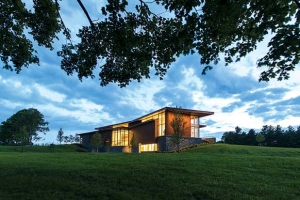
On Sunday, August 18, 2013, the Shelburne Museum in Shelburne, VT will unveil its new Pizzagalli Center for Art and Education. To commemorate the event, the Shelburne Museum will offer free admission and host a celebration throughout the institution’s campus. Festivities will kick off at 11AM with a ribbon cutting ceremony.
The Pizzagalli Center, which was designed by the Boston-based architecture firm, Ann Beha Architects, boasts 18,000-square-feet and will allow the Shelburne Museum to expand their exhibition offerings as well as implement new programming. The Center is part of the $14 million capital campaign “The Campaign for Shelburne Museum,” which includes an endowment to maintain the center.
Founded by pioneering American folk art collector Electra Havemeyer Webb in 1947, the Shelburne Museum holds one of the most remarkable and diverse collections of art and Americana. The museum’s 150,000 holdings include Impressionist paintings, folk art, quilts, textiles, decorative arts, furniture, American paintings, and various artifacts dating from the 17th to 20th century, which are exhibited in 39 different buildings. Webb collected various 18th and 19th century structures including houses, barns, a lighthouse, a jail, and a steamboat to house her collection; 25 of the buildings are historic.
Traditionally a seasonal museum, the Shelburne will stay open year-round after the Center’s inauguration for the first time in the institution’s 66-year history.
Shelburne Museum in Shelburne, Vermont, is one of North America’s finest, most diverse, and unconventional museums of art, design, and Americana. Over 150,000 works are exhibited in a remarkable setting of thirty-eight exhibition buildings, twenty-five of which are historic and were relocated to the museum’s beautifully landscaped forty-five-acre campus. Shelburne’s collection includes works by the great Impressionists Claude Monet, Edouard Manet, and Edgar Degas, as well as a prized collection of folk art including trade signs, weathervanes, and quilts.
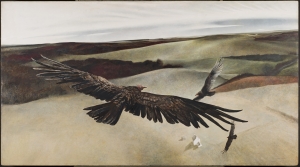
The Shelburne Museum in Shelburne, VT has organized an exhibition that explores the use of extreme perspectives, unconventional angles and powerful narratives in works by N.C. Wyeth (1882-1945), his son, Andrew (1917-2009) and Andrew’s son, Jamie (b. 1946). Wyeth Vertigo presents nearly 40 works from one of the most influential families in modern American art.
Highlights include the Shelburne’s own monumental painting by Andrew Wyeth, Soaring (1942-1950), and 39 works on loan from institutions such as the Whitney Museum of American Art and Pennsylvania Academy of Fine Arts as well as from private collections including those of the Wyeth family. Thomas Denenberg, The Shelburne Museum’s director and co-curator of the show, said, “The exhibition expands our understanding of the work of each Wyeth, while tracing a key theme that unifies the generations. Imaginative, playful, thoughtful, somber – at times even magical, the work of the Wyeths tells the story of twentieth-century America.”
Wyeth Vertigo will be on view at the Shelburne Museum through October 31, 2013 and is complemented by an exhibition catalogue published by the University Press of New England.
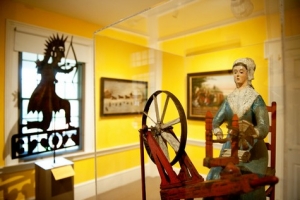
On August 18, 2013 the Shelburne Museum in Shelburne, VT will open its new Center for Art and Education. Historically a seasonal museum, the Shelburne will stay open year-round after the Center’s inauguration for the first time in the institution’s 66-year history.
The Center for Art and Education, which was designed by the Boston-based architecture firm, Ann Beha Architects, boasts 18,000-square-feet and will allow the Shelburne Museum to expand their exhibition offerings as well as implement new programming. The Center is part of the $14 million capital campaign “The Campaign for Shelburne Museum.” The campaign includes an endowment to maintain the center as well as the installation of a fiber-optic communications network throughout the Shelburne’s site, which spans 45 acres.
Founded by pioneering American folk art collector Electra Havemeyer Webb (1888-1960) in 1947, the Shelburne Museum holds one of the most remarkable and diverse collections of art and Americana. The museum’s 150,000 holdings include Impressionist paintings, folk art, quilts, textiles, decorative arts, furniture, American paintings, and various artifacts dating from the 17th to 20th century, which are exhibited in 39 different buildings. Webb collected various 18th and 19th century structures including houses, barns, a lighthouse, a jail, and a steamboat to house her collection; 25 of the buildings are historic.
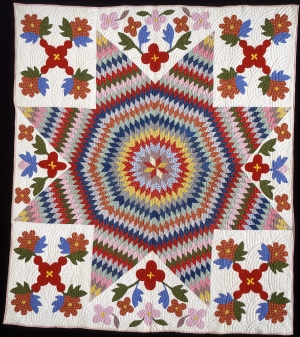
Beyond the Bed: The American Quilt Evolution, which is on view at the Katonah Museum of Art in Katonah, New York, traces the evolution of the North American quilt from the early 19th century to the present day. The exhibition is guest curated by Jean M. Burke of Vermont’s Shelburne Museum and explores how the form, fashion and, function of quilts have changed over the centuries.
Beyond the Bed presents a wide variety of objects from bed coverings, wall decorations, and clothing to three-dimensional sculptures and furniture accessories. While, some of the quilts on view are traditional in pattern and construction, others are more progressive.
Highlights include a rare pincushion quilt attributed to a member of the Vanderbilt family; Ella B. Chase’s (unknown-1919) Pickwick Papers Crazy Quilt depicting characters from Charles Dickens’ Posthumous Papers of the Pickwick Club; a tromp l’oeil quilt carved by Fraser Smith (b. 1971) from a 200-pound block of wood; and a free-standing quilted sculpture by Dominique Ehrmann.
Beyond the Bed: The American Quilt Evolution will be on view through June 16, 2013.
|
|
|
|
|